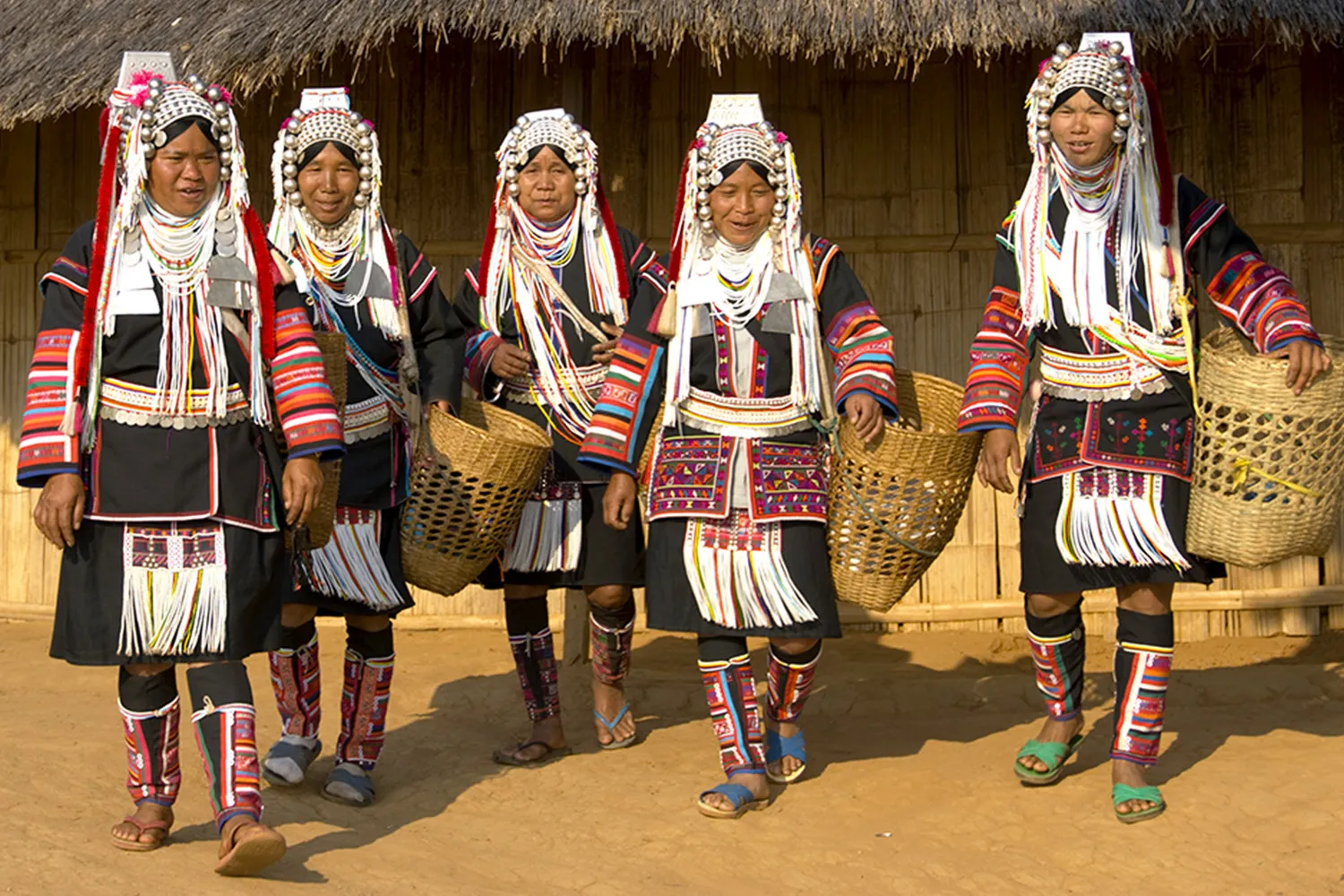The Akha people are a distinctive ethnic minority in northern Thailand, widely known for their elaborate silver headdresses and strict adherence to a traditional code of conduct known as the “Akha Way” (Akha Zan). Their history traces back to the Tibetan-Yunnan plateau in China, from which they began a slow, continuous southward migration over centuries, primarily driven by land scarcity and conflict. Today, significant Akha populations are found across China, Myanmar, Laos, and Thailand. Their main arrival in Thailand occurred during the late 19th and early 20th centuries, settling in the highest, most remote mountains of provinces like Chiang Rai and Chiang Mai. The Akha are a fiercely independent people who have historically resisted integration, choosing to live according to their own ancestral laws and beliefs, which dictate every aspect of their social, spiritual, and material lives, thus preserving one of the most culturally intact traditions in the region.
The traditional lifestyle and economy of the Akha are closely tied to the rugged mountain environment. For generations, their primary occupation has been swidden agriculture (also known as slash-and-burn or rotational shifting cultivation), necessary for cultivating staple crops like upland rice and corn on steep slopes. This practice necessitated a degree of mobility, as villages would occasionally relocate when the soil in their fields became depleted. The Akha were also traditionally involved in cultivating the opium poppy as a crucial cash crop, a practice that the Thai government has largely replaced through crop substitution programs with temperate-climate fruits, vegetables, and coffee. They are expert hunters and foragers, utilizing the forest for food, medicine, and building materials. In the modern context, Akha communities supplement their agricultural income through the sale of their renowned handicrafts and textiles to tourists, and many younger members seek wage labor in lowland towns, though the agricultural cycle still dictates the rhythm of village life.
Akha culture and spiritual life are entirely governed by the “Akha Way” (Akha Zan), a complex set of unwritten ancestral laws, beliefs, and rituals passed down orally through the generations. Their religion is a highly elaborate form of animism and ancestor worship. They believe in a fundamental balance between the world of humans and the world of spirits, with rituals dedicated to appeasing numerous spirits of the forest, water, and village. Ancestor worship is central, with a dedicated altar in every home where offerings are made to ensure the prosperity and health of the family. The social structure is highly organized around the patrilineal lineage, with Akha men able to recite their genealogy back over fifty generations. The village community is guided by a combination of the village headman (for secular affairs) and the shaman (boomo) and priest (dzoema) who manage the spiritual calendar and perform ceremonies to maintain the cosmic order prescribed by the Akha Way.
The traditional clothing of the Akha is arguably the most elaborate and immediately recognizable of the Thai hill tribes. It is characterized by the predominant use of dark indigo-dyed cotton and extensive, complex ornamentation. Akha women wear short, fitted, dark jackets and skirts over leggings, but their defining feature is the headdress, which varies slightly between sub-groups but is always spectacular. These towering, helmet-like caps are heavily adorned with intricate silver plates, beads, coins, monkey fur, and plumes. The headdress is a visual biography, often indicating the wearer’s age, marital status, and the wealth of her family. The silver jewelry, especially large breast plates and thick necklaces, is worn not just for beauty but as a form of portable wealth and protection from evil spirits. Akha men wear looser, dark-colored trousers and jackets, but often wear a distinctive shoulder bag and traditional headwear during ceremonial occasions.
Akha villages and house structures are clearly distinguishable by their design, which is fundamentally linked to their spiritual beliefs. Akha villages are typically located at high elevations and are defined by two distinctive structures: the village gates and the Akha swing. The gates are massive wooden structures located at the village entrances, featuring male and female spirit figures carved in wood to scare off evil spirits. Their houses are traditionally built on low stilts or directly on the ground and are often divided into two separate sides: one for men and guests (the public side) and one for women, children, and the ancestor altar (the sacred side), reflecting the strict separation of gender roles and spiritual spaces dictated by the Akha Way. The construction utilizes local materials like bamboo, wood, and thatch, designed to be sturdy yet relatively easily relocated if spiritual omens dictate a move.
The Akha year is rich with significant festivals and ceremonies that follow the agricultural and spiritual calendar, all of which strictly adhere to the Akha Way. The most famous is the Akha Swing Festival (known as the Yehkuja or “Eating New Rice” festival in its original form), held typically in late August or early September. This is a crucial time for giving thanks for the harvest, honoring the ancestors, and for young people to socialize. The construction of a large, elaborately decorated wooden swing is central to the festival, believed to usher in good fortune and fertility. Another important event is the New Year Celebration (following the Chinese Lunar calendar), which involves ancestor rites, communal feasting, and the sharing of traditional foods. Throughout the year, various smaller, specific rituals are performed by the priest or shaman to heal the sick, bless the crops, and ensure that the delicate balance between the human and spirit worlds is maintained.

